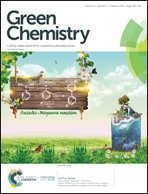Utilizing deactivated catalysts from the nitric oxide removal process for the fabrication of metal oxide/carbon supercapacitors†
Abstract
Satisfying the criteria regarding greenhouse gas (GHG) emission and economic feasibility for the production of electrochemical energy storage devices is a challenging issue in a wide range of applications because the production of such devices involves costly materials and environmentally hazardous processes and typically requires electricity generated by conventional power plants (which also emit GHGs). In this regard, we propose a strategy to utilize waste catalysts used to remove nitric oxide (NO; one of the major emissions from thermoelectric power plants) for the fabrication of supercapacitors (SCs). Specifically, copper-deposited activated carbon fibers (Cu/ACFs) from a semi-dry electroless deposition process were used as catalysts for the ammonia-free selective catalytic reduction (SCR) of NO. Even though continuous SCR operation deactivated the Cu/ACFs into copper-oxide-deposited ACFs (CuOx/ACFs) as waste catalysts, the resultant architecture is preferably available for both capacitive charge and non-capacitive charge storage. Thus, the as-received CuOx/ACF was combined with an electrolyte gel via mechanical spraying and subsequently incorporated into separating and contacting electrodes for the fabrication of all-solid-state SCs. The fabricated SCs demonstrated superior volumetric capacitance and cycling stability, supporting the feasibility of utilizing waste NO removal catalysts in electrochemical energy storage.



 Please wait while we load your content...
Please wait while we load your content...